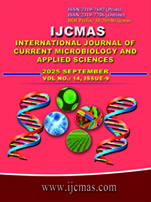


 National Academy of Agricultural Sciences (NAAS)
National Academy of Agricultural Sciences (NAAS)

|
PRINT ISSN : 2319-7692
Online ISSN : 2319-7706 Issues : 12 per year Publisher : Excellent Publishers Email : editorijcmas@gmail.com / submit@ijcmas.com Editor-in-chief: Dr.M.Prakash Index Copernicus ICV 2018: 95.39 NAAS RATING 2020: 5.38 |
Fusarium wilt, caused by Fusarium oxysporum f. sp. lycopersici, is one of the most destructive diseases affecting tomato production worldwide. The present study evaluated 60 tomato genotypes under controlled pot culture to assess variation in growth, yield, biochemical traits, and disease response. Data were analyzed using one-way ANOVA, pooled ANOVA, correlation, and principal component analysis (PCA). Significant differences were observed among genotypes for number of leaves per plant, number of branches per plant, total soluble solids, phenolic content, and fresh weight of fruit per plant. Disease severity ranged from 46.8% to 77.2%, with genotypes such as D1, D2, and Arka Rakshak exhibiting reduced wilt incidence, while H30 and D16 were highly susceptible. Biochemical analysis indicated that higher phenolic accumulation was associated with reduced disease severity, suggesting a role in defense mechanisms. Correlation analysis revealed a negative relationship between disease severity and yield as well as quality traits, whereas phenolic content showed a positive association with total soluble solids. PCA grouped genotypes based on trait performance, with tolerant and high-yielding entries (e.g., D1, Arka Rakshak, Arka Alok) clustering together, distinct from susceptible lines. These results highlight the genetic variability among tomato genotypes and demonstrate the utility of combining morphological, biochemical, and multivariate analyses in identifying resistance sources. The identified promising genotypes may serve as valuable candidates in breeding programs for developing wilt-tolerant tomato cultivars with stable yield and superior fruit quality.
Agrios, G. N. (2005). Plant pathology (5th ed.). Elsevier Academic Press.
Chitwood-Brown, J., Vallad, G. E., Lee, T. G., & Hutton, S. F. (2021). Breeding for resistance to Fusarium wilt of tomato. Genes, 12(11), 1673.https://doi.org/10.3390/genes12111673
García-Barrera, L. J., Meza-Zamora, S. A., Noa-Carrazana, J. C., & Delgado-Macuil, R. J. (2024). Chemometric analysis using infrared spectroscopy and PCA-LDA for early diagnosis of Fusarium oxysporum in tomato. Tree Physiology, 44(5), 707–717. https://doi.org/10.1007/s41348-024-00978-y
Garibaldi, A., Gilardi, G., & Gullino, M. L. (2018). Emerging soilborne diseases of tomato and management strategies. Acta Horticulturae, 1207, 15–24. https://doi.org/10.17660/ActaHortic.2018.1207.3
Heikal, Y. M. (2025). Integrated management of tomato Fusarium wilt: Ultrastructure insights into Zn nanoparticles and phytohormone applications. Cells, 14(14), 1055. https://doi.org/10.3390/cells14141055
Hibar, K., Daami-Remadi, M., Khiareddine, H., & El Mahjoub, M. (2007). Induction of resistance to Fusarium oxysporum f. sp. radicis-lycopersici in tomato by Trichoderma spp. Tunisian Journal of Plant Protection, 2(1), 47–58.
Kumar, R., Sharma, S., & Singh, M. (2020). Morphological and physiological basis of Fusarium wilt resistance in tomato. Journal of Plant Diseases and Protection, 127(2), 145–154. https://doi.org/10.1007/s41348-020-00297-9
Kumar, R., Sharma, S., & Singh, M. (2020). Morphological and physiological basis of Fusarium wilt resistance in tomato. Journal of Plant Diseases and Protection, 127(2), 145–154. https://doi.org/10.1007/s41348-020-00297-9
Mandal, S., Mallick, N., & Mitra, A. (2010). Salicylic acid-induced resistance to Fusarium oxysporum f. sp. lycopersici in tomato. Plant Physiology and Biochemistry, 48(7), 666–672. https://doi.org/10.1016/j.plaphy.2010.05.001
Mandal, S., Mallick, N., & Mitra, A. (2010). Salicylic acid-induced resistance to Fusarium oxysporum f. sp. lycopersici in tomato. Plant Physiology and Biochemistry, 48(7), 666–672. ttps://doi.org/10.1016/j.plaphy.2010.05.001
McGovern, R. J. (2015). Management of tomato diseases caused by Fusarium oxysporum. Crop Protection, 73, 78–92.https://doi.org/10.1016/j.cropro.2015.02.021
Singh, V., Singh, D., & Singh, A. (2017). Variability and resistance in tomato genotypes against Fusarium wilt. Vegetable Science, 44(2), 220–225.
Singh, V., Singh, D., & Singh, A. (2017). Variability and resistance in tomato genotypes |
 |
 |
 |
 |